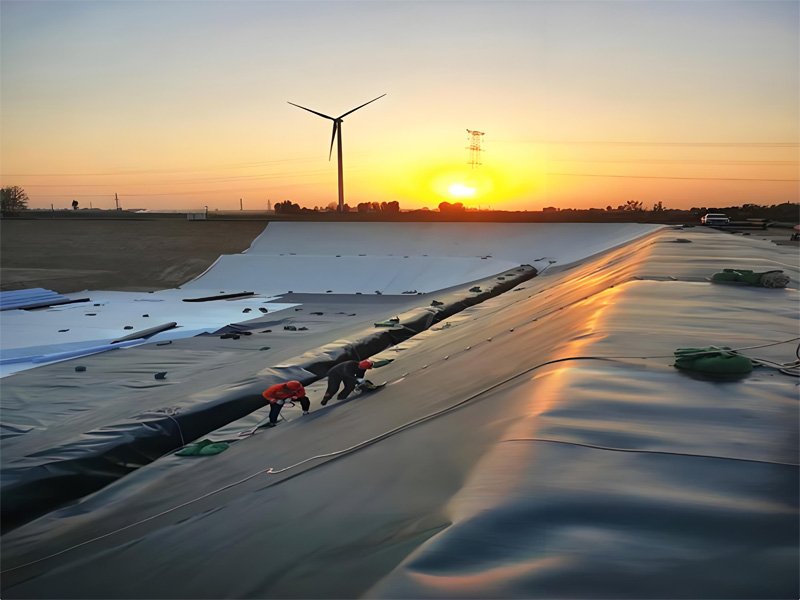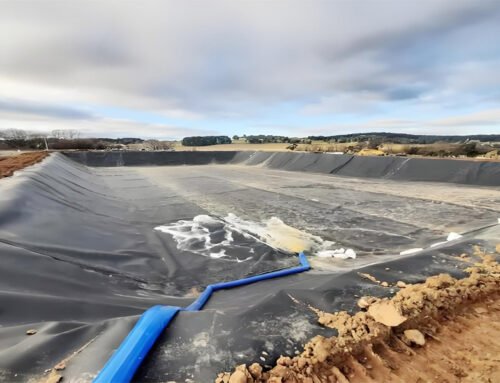HDPE pool liner is also called HDPE anti-seepage geomembrane, it is made of polyethylene virgin resin and a certain proportion of carbon black black master batch, blue color master batch, anti-aging agent, anti-oxidant agent, ultraviolet absorber stabilizer, etc., And is blown by single-layer,double-layer and three-layer co-extrusion technology.It has excellent anti-seepage performance and various application fields. In this article we will learn more about GEOSINCERE HDPE Pool liner and its applications.
1. What Is HDPE Pool Liner?
High-Density Polyethylene (HDPE) pool liners are impermeable membranes specifically designed for use in various aquatic environments, including swimming pools, ponds, and water features. Made from high-density polyethylene, these liners offer several advantageous properties, making them a popular choice in the construction and maintenance of water bodies.
Specifications of HDPE Pool Liner including:
- Thickness:Commonly available in thicknesses ranging from 0.5 mm to 2 mm (20 mil to 80 mil), with thicker options providing additional durability.
- Width & Length:Normally, Width:3-8M, Length:50-200M.
- Color:Available in multiple colors, including black, blue, green, and white, allowing for aesthetic customization to match the environment.
- Material Composition:Made from high-density polyethylene (HDPE) with a minimum density of 0.94 g/cm³, ensuring structural integrity and resistance to environmental factors.
- Tensile Strength:Typically possesses a tensile strength of at least 20 MPa, providing sufficient strength to withstand various environmental stresses.
- Elongation:Features an elongation at break of approximately 300% to 500%, allowing for flexibility during installation and in response to ground movement.
- Temperature Range:Operational temperature range typically from -40°C to +80°C (-40°F to +176°F), suitable for various climatic conditions.


2. What Are Main Features Of HDPE Pool Liner?
High-Density Polyethylene (HDPE) pool liners are becoming increasingly popular due to their durability and performance. If you’re considering an HDPE pool liner for your swimming pool, understanding its main features can help you make an informed decision. Here’s a detailed look at what sets HDPE pool liners apart:
2.1 Durability and Longevity:
- Resistant to Punctures and Tears: HDPE is known for its high tensile strength, making it less susceptible to punctures and tears compared to traditional vinyl pool liners.
- UV Resistance: HDPE has excellent resistance to ultraviolet (UV) rays, which helps prevent degradation and prolongs the lifespan of the liner.
- Chemical Resistance: This liner is designed to withstand pool chemicals, ensuring durability. It resists chlorine and bromine, maintaining integrity in harsh conditions. Longevity is guaranteed even under extreme exposure.
2.2 Environmental Benefits:
- Non-Toxic Material: HDPE is made from non-toxic materials, making it safe for both humans and the environment.
- Recyclable: Unlike some other pool liner materials, HDPE is recyclable, contributing to more sustainable waste management practices.
2.3 Ease of Installation and Maintenance:
- Flexible and Lightweight: Despite its durability, HDPE is flexible and lightweight, which makes installation easier and faster.
- Low Maintenance: The smooth surface of an HDPE liner resists algae and bacterial growth. This makes it easier to clean and maintain compared to textured surfaces.
2.4 Cost-Effectiveness:
- Long-Term Savings: While the initial cost of an HDPE pool liner may be higher than some alternatives, its longevity and low maintenance needs translate into significant long-term savings.
- Reduced Repair Costs: Due to its durability, the need for repairs or replacements is minimized, further reducing overall costs.
2.5 Aesthetic Versatility:
- Variety of Colors and Patterns: HDPE pool liners come in a wide range of colors and patterns, allowing you to customize the look of your pool to match your aesthetic preferences.
- Seamless Appearance: The material can be manufactured in large sheets, providing a seamless appearance that enhances the visual appeal of the pool.
2.6 Thermal Properties:
- Temperature Stability: HDPE retains properties across wide temperature range, ensuring effectiveness and functionality through seasonal changes.
- Insulation: It offers good insulation properties, helping to maintain water temperature and reduce heating costs.
2.7 Customization and Adaptability:
- Custom Fit: HDPE can be custom-made to fit any pool shape and size, providing a perfect fit that maximizes coverage and effectiveness.
- Compatibility with Different Pool Types: No matter the pool type—above-ground, in-ground, or custom-shaped—HDPE liners offer tailored solutions.
3.Where To Use HDPE Pond Liner Geomembrane ?
3.1 Water Conservancy Projects
HDPE pond liners are extensively used in reservoirs and dams. They provide effective anti-seepage solutions. These geomembranes prevent water leakage. They ensure safety and stability of projects. They contribute to sustainable water management.
3.2 Environmental Protection Projects
In environmental applications, HDPE geomembranes play a critical role in landfills, hazardous waste treatment sites, and sewage treatment plants. They effectively prevent the leakage of harmful substances, protecting the environment and public health from contamination and pollution.
3.3 Construction Engineering
HDPE geomembranes are essential in construction for waterproofing and isolation purposes in various structures, including roofs, basements, tunnels, and subways. Their superior impermeability helps prevent water seepage and leakage, thereby ensuring the integrity and stability of buildings and infrastructure.
3.4 Traffic Engineering
In traffic engineering, HDPE geomembranes are used to provide anti-seepage and isolation solutions for roads, railways, and airports. These applications help prevent water infiltration, thereby enhancing the safety and stability of transportation networks.
3.5 Agricultural Engineering
HDPE geomembranes are crucial in agricultural settings, particularly in water conservancy irrigation systems, breeding ponds, orchards, and vegetable fields. By preventing seepage and optimizing water resource utilization, these geomembranes significantly improve irrigation efficiency and agricultural productivity.
3.6 Other Applications
In addition to the aforementioned uses, HDPE geomembranes are applied in various specialized applications such as oil depot anti-seepage, lotus root pond containment, and artificial lake isolation. These applications effectively prevent the leakage of oil and water resources, safeguarding the environment and preserving vital natural resources.


4.How To Install HDPE Pond Liner Geomembrane?
4.1 Construction preparation
- Ensure that a detailed construction plan has been developed before construction, and HDPE geomembrane materials should be purchased according to design requirements.
- Clean the foundation, remove sharp objects, fill in potholes and make sure the ground is flat.
- Check the construction environment to ensure that the outdoor temperature is above 5°C, the wind does not exceed level 4, and there is no rain or snow.
4.2 Laying method:
For large HDPE geomembrane bundles, use tractors and winches for efficient laying. For smaller bundles, manual laying is suitable, starting from the slope’s top. Ensure proper relaxation to prevent damage, with T-shaped joints to avoid crosses.
4.3 Welding and connection:
Before welding, ensure the weld area is free from oil and dust. The overlapping section of the HDPE geomembrane must be clean, with no sand or debris present.
4.4 Quality inspection and protection:
During HDPE geomembrane laying and welding, inspect for damage, pits, or holes. Post-laying, pre-coverage with protective layer, place 20-40kg sandbags every 2-5m at corners to secure.
5. Conclusion
HDPE pool liners are popular for UV, chemical resistance, and flexibility. Geosinere geomembranes withstand wear, harsh solutions, and exposure, making them ideal for various applications. These geomembranes are cost-effective compared to traditional clay and concrete systems. Unlike flexible PVC, HDPE geomembranes lack plasticizers or fillers, preventing premature cracking and extending service life. Choosing Geosinere ensures sustainability, environmental protection, and economic viability.





